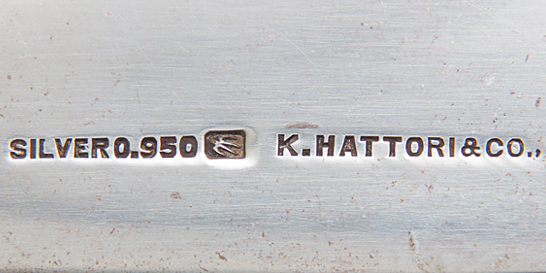
Hattori, Kintaro [服部金太郎] (1860 ~ 1934)

Kintaro Hattori in 1890 (left), 1907 (middle) and late 1920's (right).

The K. Hattori building in the Ginza district in 1895.

Tsuruhiko Yoshikawa.

The entrance to the Seikosha factory in 1897.

The office building of Seikosha in 1909.

Panoramic view on Seikosha Clock Factory in 1920.

Seikosha’s first pocket watch.

The "Laurel" wristwatch (1913).

Seikosha Factory in 1930.

K. Hattori & Co. in 1932.
Addresses and locations
Ginza 4-chome, Kyobashi-ku, Tokyo.
Exhibitions
Participated in the following exhibitions (incomplete list):
1914: Tokyo Taisho Exhibition (Tokyo, Japan).
1933: A Century of Progress International Exposition (Chicago, USA).
Exhibition record (Translation) |
Exposition (1933) record |
Marks
K. Hattori Co
hallmark
hallmark
Trade mark of the K. Hattori Co.:
服部時計店
服部 (Hattori) 時計 (watch) 店 (store)
Hatori tokei ten
Hattori's watch store
服部時計店
服部 (Hattori) 時計 (watch) 店 (store)
Hatori tokei ten
Hattori's watch store
純銀服部製
純 (sterling) 銀 (silver) 服部 (Hattori) 製 (made by)
Jungin Hattori sei
Sterling Silver, Made by Hattori
純 (sterling) 銀 (silver) 服部 (Hattori) 製 (made by)
Jungin Hattori sei
Sterling Silver, Made by Hattori
Marks in English
Stickers
Cloth label
Individual marks of artists from the K. Hattori company
幸正
Yukimasa
Yukimasa
Advertisements
Examples (from the web)
References
Seiko website.
"Japan In The Taisho Era", by Iwata Nishizawa, 1917, p. 591.
"Present-Day Impressions of Japan", by W. H. Morton-Cameron and W. Feldwick, Chicago: Globe Encyclopedia Co., 1919, pp. 638-640.
"The Universal Dictionary of Foreign Business in Modern China", by Huang Guangyu, 1995, p. 437.
"Japan to-day; a souvenir of the Anglo-Japanese exhibition held in London 1910", by Mochizuki Kotaro, 1910, p. 582.















































































